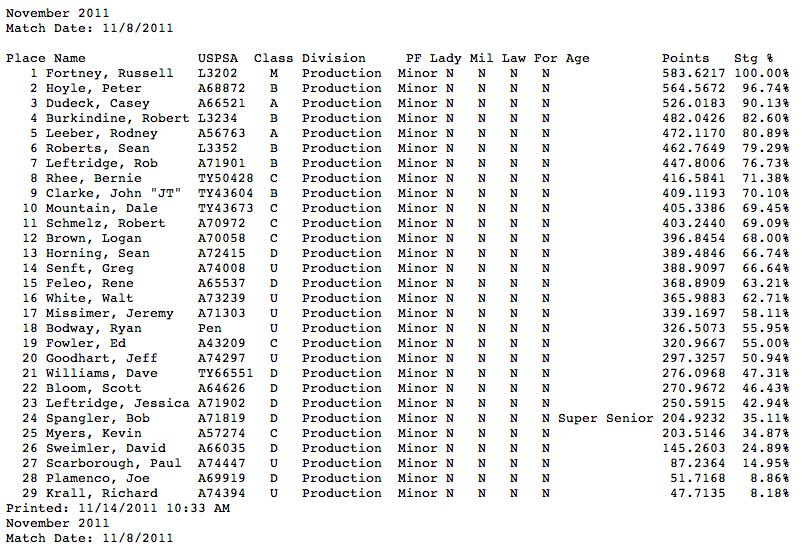
This past Sunday I woke up bright and early to begin my USPSA Match Prep Ritual. First I made sure that my Smith & Wesson M&P was tucked comfortably in my range bag. Next I removed any unnecessary ammunition and made sure that I had plenty of 9mm on hand to complete the match. I made sure that both my Countour HD and Flip HD Ultra were charged and placed into my range bag. Last, I tossed in a couple of bottles of Power Aide, some trail mix, and kissed my wife and daughter before I walked out the door.
I had never shot at York IWLA but heard good things about the club. The most important was that they ran a challenging match that was well rounded. With the address punched into my phone for GPS Navigation, I pulled out of my parking spot and was off.
The club was a bit further away than I would have liked but the drive wasn’t bad, even if it did feel like I was making a cross-county trek. I arrived a few minutes before registration opened and spent some time chatting with my newest shooting buddy, Scott.
After paying my fee ($25.00 for a special four stage classifier) and getting geared up, we were squadded up and shooting. Unlike my past eperience with USPSA, things were much more laid back than I was accustomed to. For starters, there was no set shooting order. Everyone kind of shot when they felt the urge. This threw me off my game a bit because I was so used to following an order that I would build a routine around it.
Not knowing when I would be shooting, I found myself less concentrated on creating a game plan for myself and more worried about getting the stage reset and pasted for the next shooter. Another new-to-me practice was the use of Palm devices to track scores. Since I wasn’t scoring, it didn’t effect me directly but the devices were causing some hiccups from time to time.
My biggest concern on the day wasn’t the stage design, it was that I wasn’t 100%. I was at the tail end of a cold and found myself popping cough drops like they were candy (if I didn’t, I was falling into coughing fits) to keep myself from coughing during a stage.
Even though I wasn’t feeling too great, I managed to shoot okay. I placed 29th out of 50 Shooters Overall and 16th out of 29 Shooters in Production Division. I met some very nice people and received some great pointers on improving my game. All in all, I enjoyed the match and hope to shoot at York IWLA again next season.
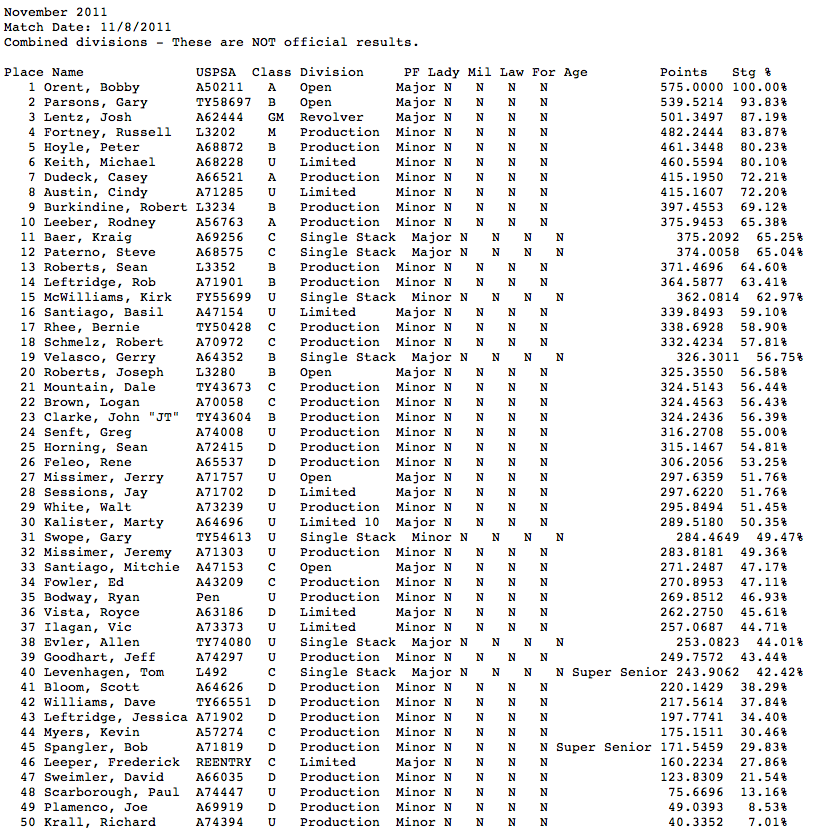
Stage 1: Melody Line
The first stage of the day was Melody Line . This stage was also the first of four classifier stages peppered throughout the match. The objective was to stand, facing up range, turn and engage each target with one round, perform a mandatory reload, and engage each target with one more round.
. This stage was also the first of four classifier stages peppered throughout the match. The objective was to stand, facing up range, turn and engage each target with one round, perform a mandatory reload, and engage each target with one more round.
Shooting the stage in this fashion tripped up a couple of people. Normally we engage targets with as many rounds as we need, then score the best two. In this case, firing out of the sequence outlined in the stage description resulted in a penalty.
At the buzzer, I turned and began engaging targets. My first six shots fired felt good and my transitions were smooth. I fumbled with the reload (proof that I need more practice at home doing dry-fire practice and reloads). My next four shots also felt good, then I had a malfunction and felt like a deer in the headlights. I went through the motions (tap-rack-bang) without issue but I probably wasted two seconds before my next shot broke.
I shot this stage in 14 seconds with a score of 7 A’s and 5 C’s. I placed 17th out of 29 shooters in production division.
Stage 2: Lightning and Thunder
Lightning and Thunder was our second classifier of that day. When I laid eyes on this stage during our shooter briefing that morning, I immediately became curious. It was the first time that I have ever seen a stage setup to run multiple shooters across a firing line (it was setup to run three at a time to save time).
was our second classifier of that day. When I laid eyes on this stage during our shooter briefing that morning, I immediately became curious. It was the first time that I have ever seen a stage setup to run multiple shooters across a firing line (it was setup to run three at a time to save time).
Facing down range, shooters are to wait for the buzzer, draw, and engage three targets from 75 feet. Best two rounds on paper score while misses do not cause any penalties. The difficulty here was that a par time of five seconds was used. In a nutshell, you have five seconds to draw and engage three targets, with a total of six rounds, before your time was up.
To prep for this stage, I stood away from the shooters and air-gunned the stage as others ran it. This gave me a feel for how fast I needed to be moving before the buzzer ended the stage. When it was my turn, I wound up shooting too fast and having a little time left over. It would have been in my best interest to slow down and take advantage of that extra time in an effort to place my shots better.
Once the other two shooters were finished (again, three on the firing line shooting at their own targets), we moved to a closer firing line at 45 feet. The par time of five seconds remained but this time we were to draw, engage each target with one round, perform a mandatory reload, and fire one more round at each target. Same rules applied as above where misses didn’t draw a penalty.
This time I was able to draw my pistol, fire three rounds, reload, and fire two more rounds before I ran out of time. With my slow reload time, I really had to hustle to break those last two shots and I knew right away that they wouldn’t be placed well on the target.
For the last leg of the stage, we moved up to a firing line at 30 feet from the targets. With the same par time, we were to draw and engage each target with two rounds, strong hand only (for me this meant shooting with my right hand). Much like the first leg, I got all of my shots off with time left over. Again, just like the first leg, I should have took more time in setting up my shots instead of worrying so much about the 5 second par time.
Fortunately, this stage did not penalize misses otherwise I would scored a big fat zero. I wound up with 2 A’s, 1 B, 3 C’s, 3 D’s, and 7 misses. I came in 21st out of 29 shooters.
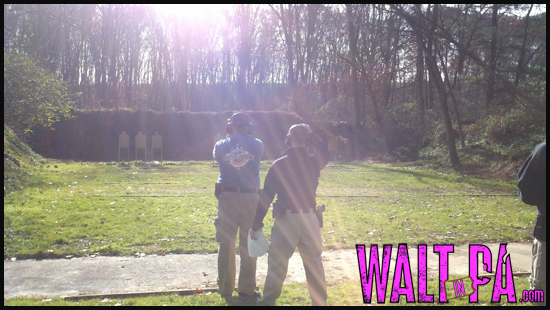
Stage 3: Razor’s Edge
Stage three was Razor’s Edge, another classifier. This was the most disappointing stage of the day, not because I shot it poorly, but because I was fidgeting with the camera prior to the start and forgot to turn it on for my run. As a result, I have no footage to look back on for this stage.
This stage was setup so that the shooter stood behind a wall with a long cutout in it. The cutout was situated so that a person of average height had to crouch down slightly, creating an awkward shooting stance.
The wall was placed 30 feet from the targets and we were to start with out hands on two marks on the wall. At the buzzer, we were to draw and engage six targets with one round per target. Some targets were shrouded by no shoots while others were, more or less, wide open.
Without video footage of my shooting, it is tough to explain what I did well and where I needed work. From what I recall, my time wasn’t lightning fast but my shots were well placed.
Because I didn’t have video from this stage, I have no way of knowing how I landed my shots. The scoring system posted by the club is rather confusing and the official report is not available from USPSA at this time. I ranked 8th out of 29 shooters on this stage with a time of 7.41 seconds and 28 points.
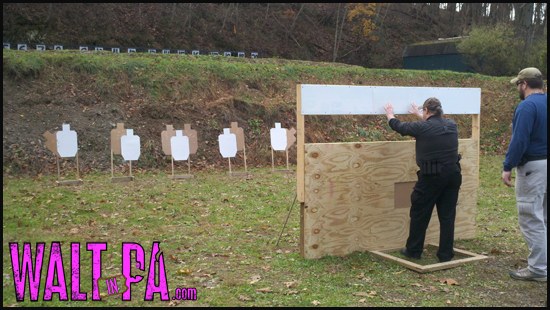
Stage 4: Pit 4
Pit 4 was our fourth stage of the day and our first look at a stage that was not a classifier. The nice thing about not shooting a classifier is that the stages are more complicated and they allow you to stretch your legs a bit. Being confined to a small shooting box gets kind of old after a few stages.
At the buzzer, we were to draw and begin engaging targets as we saw fit. The most logical targets to engage first were a pair tucked down behind a fence. With some careful footwork around a muddy patch, I reached over the fence and quickly point-shot both targets before getting back on the move.
My next pair or targets were situated behind fencing. In order to get a clear shot on these targets, you had to get close to a gap in the fence. From here, a few quick shots, careful not to hit the no shoot, and the real fun sets in.
Up until this point the stage seemed very logical in the way that I engaged targets. At this point I had a wide variety of options and I struggled on selecting what I thought was best. I decided to turn to my right and engage a single target at fairly close range.
I ran my gun dry and reloaded as I moved towards the back left corner of the stage. I leaned left, over the boundary, and engaged a pair of targets before moving to the right and engaging another pair.
I reloaded before making my way to a port (opening in a fence) to begin working on the plate rack at fairly close range. I expected the steel to be a piece of cake. I put my front sight on the steel plate and pressed the trigger. To my surprise, the gun went off and the steel remained standing. I reset and pressed the trigger again, and still the steel stood untouched, as if it were mocking me.
I took a breath, refocused, and went back at the steel. The first plate dropped and the rest were on and off. I used almost an entire magazine to knock down six steel plates. I still have no idea why those plates didn’t drop. According to my front sight, they should have went down without issue. I must have been pulling the shots or something.
On this stage, scoring was started before the stage was over (score keeper walking behind as the range officer and I moved further into the stage). As a result, I don’t have any video of my targets being scored. Looking at the club results, I managed 106 points in 27.55 seconds. I came in 11th out of 29 shooters in this stage.
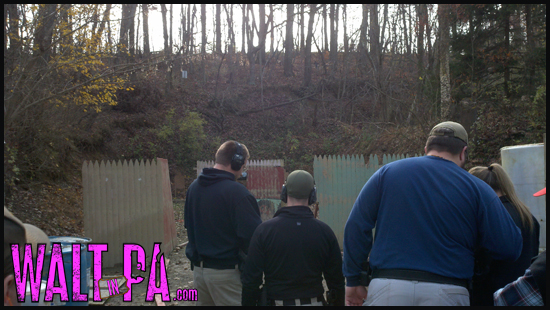
Stage 5: Cracker Jack
Cracker Jack was our fifth stage and last classifier of the day. Standing in a shooting box, hands on X’s on the fence, we waited for the buzzer. Once alerted, we would draw our weapon and engage a series of six targets in any manner we saw fit.
was our fifth stage and last classifier of the day. Standing in a shooting box, hands on X’s on the fence, we waited for the buzzer. Once alerted, we would draw our weapon and engage a series of six targets in any manner we saw fit.
I decided, as did many other shooters, that it would be best to engage the first four targets immediate infront of us. A pair were setup at 47 feet with another pair setup at 50 feet. The closer targets were partially painted black to indicate hard cover (a shot in the black counts as a miss). The other pair were wide open.
Holding for A zone shots, I pressed the trigger eight times and moved to my left. Around a corner, at about 8 feet from the box, was a single target. I fired two rounds and moved to my right to engage a single target setup in much the same fashion.
All of my shots were solid, landing in the A and C zones. Unfortunately, two of my A zone shots were inside black painted hard cover, counting as misses. The two penalties killed my final score. Normally I hold a little away from hard cover just to make sure my shots score. This time I threw caution to the wind and took my chances by holding for a solid A zone shot.
On this stage I scored 44 points before I was penalized 20 points for my two misses (I hit hard cover, which counts as a miss). I ran the stage in 12.51 seconds and came in 22nd out of 29 shooters.
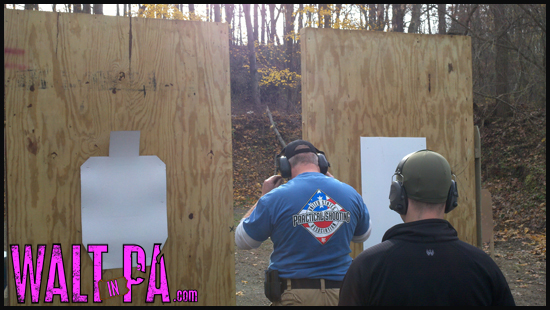
Stage 6:
Pit 6 was our sixth stage of the day and looked to be one of the most fun stages. Laid out in front of us was this zig-zag looking firing line that was very narrow. There were seven targets setup on the extreme left side of the pit and seven targets on the extreme right. At the end of this zig-zag path were two targets tucked down behind a fence.
Shooters seemed to be approaching this stage in one of two ways. Some immediately moved to a part of the firing line where they could engage a large number of targets, then moved again to engage the remainder. Other shooters slowly moved down the zig-zag path picking off targets while moving.
I opted to turn to the left string of targets and run my gun dry without moving. I then reloaded and repeated the process on the right string. While reloading, I moved further down the path and picked up the two remaining targets on the left and the two remaining targets on the right. I reloaded one last time while moving towards the fence to pick up my last two targets.
On this stage a racked up 134 points in 30.67 seconds, putting me in 14th place out of 29 shooters.
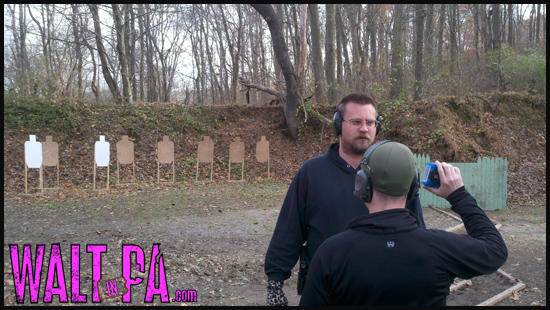
Stage 7:
The last stage of the day was Pit 7. This stage had a couple of my squad members a little concerned due to the presence of both a swinger and a Texas star. Mixed in with these two pesky targets were a mixture of steel poppers and cardboard.
When it was my time to shoot, I opted to shoot as much cardboard as I could from the starting position. I started with a target on the far left, then transitioned to my right for the next target in the string. The third target required me to lean around a No-Shoot but posed no problems. I picked up a close range target before reloading and firing on the last close range target.
I moved to the far right of the shooting lane and picked up a target tucked behind a fence. I point-shot this target (fired without looking at my sights due to close range) and I felt like I pulled one of my shots into the hard cover portion of the target. I made up the shot, turning to my left to pick up two more targets at medium distance.
With one of these targets I felt like I may have pulled another shot into hard cover. I made up the shot and began moving down the firing line to a break in the fence. I started on the steel from right to left. Shooting in this manner allowed me to hit the piece of steel that actuated the swinger, last. With the slight delay, I setup to ambush the swinger.
I moved back to the starting area to engage the Texas Star. I’ve had mixed results with these targets but I wasn’t terribly worried about it. I was confident in my shooting, put my front sight on the first plate and pressed the trigger. Much like earlier in the day, the steel remained standing and it took a few more shots to drop the first plate.
Once the first plate was down, I had my rhythm hitting plate after plate as the Texas Star went into motion. On the last shot, I pulled the trigger and my brain immediately told me that I missed, but to my surprise, the last plate fell.
After reviewing the footage, I could see that my brain was correct. I missed my last shot but the momentum of the swinging plates must have disengaged the steel target, causing it to drop. it was a range equipment failure that no one noticed at the time.
My biggest issue on this stage was my lack of focus. As the day went on, I was developing some sort of shooting fatigue. My follow through was becoming shorter and shorter until I was actually transitioning to the next target a split second before the shot broke. This resulted in me pulling shots that required me to make them up, costing me time and throwing off my plan in regards to where I would reload.
On this stage I scored 143 points in 43.20 seconds, earning me 14th place out of 29 shooters.
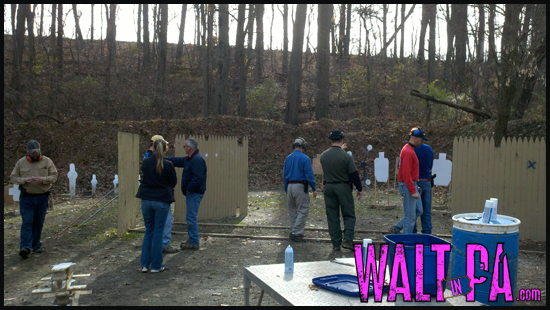
Closing Thoughts:
The nice thing about the match at York IWLA is that it was a special event setup with four classifier stages. The way USPSA works is that the organization uses these stages, which are the same nationally, to place a shooter into a specific class. Four of these stages are needed to generate a classification. Between these four and the two that I shot at Lower Providence Rod & Gun Club, I should have a brand new membership card with a classification on it (right now it has “U” for unclassified).
When I look over the scores from the match, I could see a trend. If I didn’t bomb a stage with misses, I fell into the middle of the pack. In this case, I shot better than the average “D” ranked shooter on several stages and found myself towards the bottom of the “C” class pack.
I have no idea what my classification will be when it is generated. I will be disappointed if I rank “D” but would completely understand (a tanked stage, here and there, will undoubtably drag me down). I’ve got my fingers crossed for “C”.
Match Video from York IWLA – Nov. 2011
4 thoughts on “Match Results: USPSA at York IWLA”
Comments are closed.
Recent Posts
The Price of Rushing: A Winter Riding Story & Four Years of YouTube Friendship
You know those moments when you do something that isn't exactly catastrophically stupid, but just stupid enough to make you shake your head at yourself? Yeah, we've all been there, and today I'm...
Finding Joy in Unexpected Places: A Memorable Motorcycle Ride to Remember
As we roll into 2025, I've been reflecting on the rides that made 2024 special. While the year didn't provide as many opportunities to hit the road as I'd hoped, one particular adventure stands out...

Two things walt the first is I forgot you were almost dying but still out there shooting , hardcore man and hope you’re feeling better. Also how was topton?
Scott,
I’ve been feeling much better, thanks.
The match at Topton us actually today (Sunday – 10:30 Registration Closes). It is listed on the website as “Classifier Match” but doesn’t give any specifics. I’m not sure what to expect but I hope it means that scores will be reported to USPSA.
I would almost bet you make c class , you’ll have your six and get it.
Scott,
I was looking at my USPSA Member Profile under Classifiers and I didn’t see anything listed. I’m not sure if they only list classifier information when you meet the minimum requirements, but I hope between the two at Lower Providence in October and the four at York, I’ll have my classification next cycle.